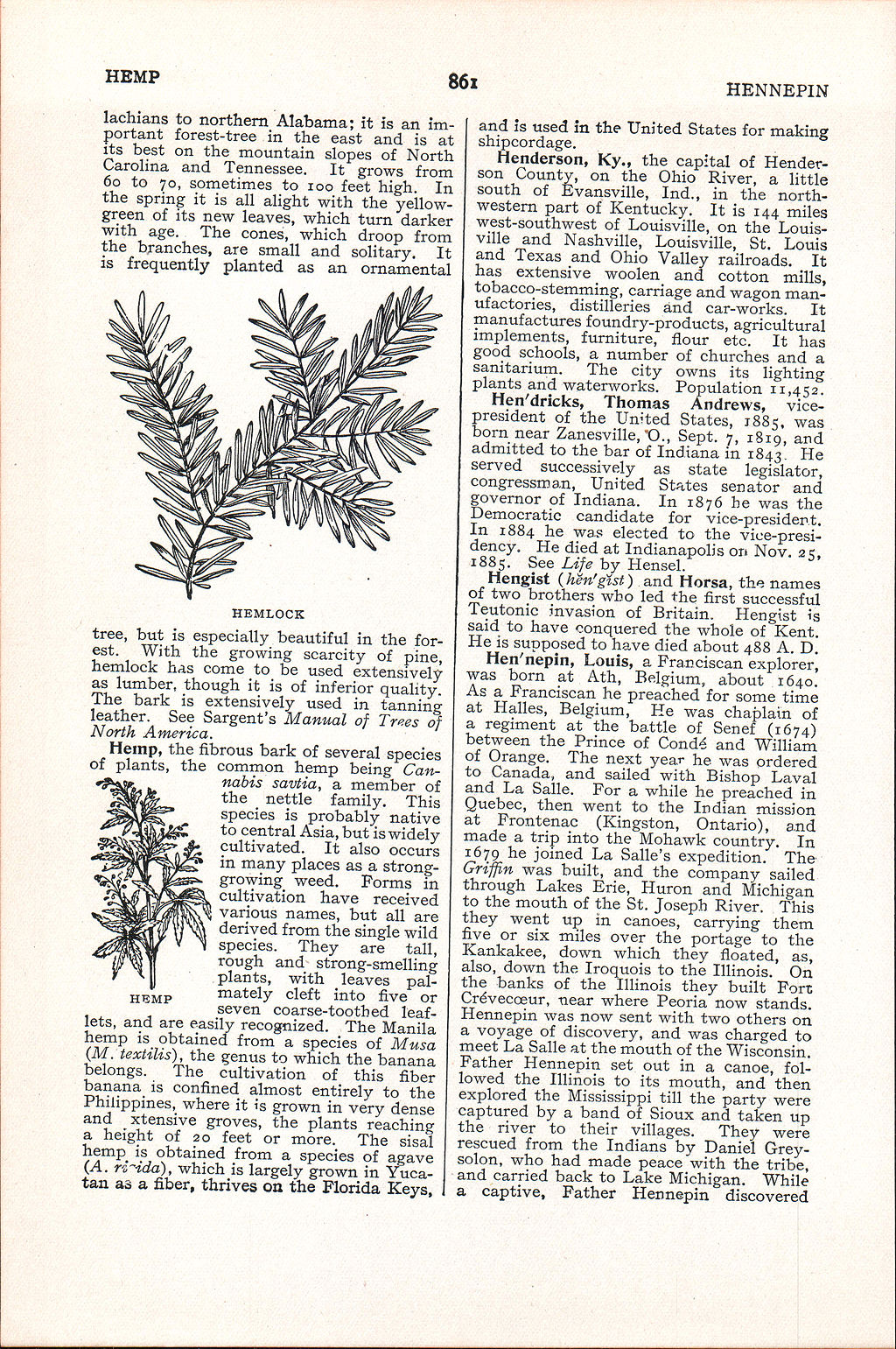HEMP
861
HENNEPIN
lachians to northern Alabama; it Is an important forest-tree in the east and is at its best on the mountain slopes of North Carolina and Tennessee. It grows from 60 to 70, sometimes to 100 feet high. In the spring it is all alight with the yellow-green of its new leaves, which turn darker with age. The cones, which droop from the branches, are small and solitary. It is frequently planted as an ornamental
HEMLOCK
tree, but is especially beautiful in the forest. With the growing scarcity of pine, hemlock has come to be used extensively as lumber, though it is of inferior quality. The bark is extensively used in tanning leather. See Sargent's Manual of Trees of North America.
Hemp, the fibrous bark of several species of plants, the common hemp being Can-nabis savtia, a member of the nettle family. This species is probably native to central Asia, but is widely cultivated. It also occurs in many places as a strong-growing weed. Forms in cultivation have received various names, but all are derived from the single wild species. They are tall, rough and strong-smelling plants, with leaves pal-mately cleft into five or seven coarse-toothed leaflets, and are easily recognized. The Manila hemp is obtained from a species of Musa (M, textilis), the genus to which the banana belongs. The cultivation of this fiber banana is confined almost entirely to the Philippines, where it is grown in very dense and xtensive groves, the plants reaching a height of 20 feet or more. The sisal hemp is obtained from a species of agave (A. ri~<idd), which is largely grown in Yucatan as a fiber, thrives on the Florida Keys,
HEMP
and Is used in the United States for making shipcordage.
Henderson, Ky., the capital of Henderson County, on the Ohio River, a little south of Evansville, Ind., in the northwestern part of Kentucky. It is 144 miles west-southwest of Louisville, on the Louisville and Nashville, Louisville, St. Louis and Texas and Ohio Valley railroads. It has extensive woolen and cotton mills, tobacco-stemming, carriage and wagon manufactories, distilleries and car-works. It manufactures foundry-products, agricultural implements, furniture, flour etc. It has good schools, a number of churches and a sanitarium. The city owns its lighting plants and waterworks. Population 11,452.
Hen'dricks, Thomas Andrews, vice-president of the United States, 1885, was born near Zanesville, XX, Sept. 7, 1819, and admitted to the bar of Indiana in 1843. He served successively as state legislator, congressman, United States senator and governor of Indiana. In 1876 he was the Democratic candidate for vice-president. In 1884 he was elected to the vice-presidency. He died at Indianapolis on Nov. 25, 1885. See Life by Hensel.
Hengist (hen'gist) and Horsa, the names of two brothers who led the first successful Teutonic invasion of Britain, Hengist is said to have conquered the whole of Kent. He is supposed to have died about 488 A. D.
Hen'nepin, Louis, a Franciscan explorer, was born at Ath, Belgium^ about 1640. As a Franciscan he preached for some time at Halles, Belgium, He was chaplain of a regiment at the battle of Senef (1674) between the Prince of Cond^ and William of Orange. The next year he was ordered to Canada, and sailed with Bishop Laval and La Salle. For a while he preached in Quebec, then went to the Indian mission at Frontenac (Kingston, Ontario), a,nd made a trip into the Mohawk country. In 1679 he joined La Salle's expedition. The Griffin was built, and the company sailed through Lakes Erie, Huron and Michigan to the mouth of the St. Joseph River. This they went up in canoes, carrying them five or six miles over the portage to the Kankakee, down which they floated, as, also, down the Iroquois to the Illinois. On the banks of the Illinois they built Fort CreVecceur, near where Peoria now stands. Hennepin was now sent with two others on a voyage of discovery, and was charged to meet La Salle at the mouth of the Wisconsin. Father Hennepin set out in a canoe, followed the Illinois to its mouth, and then explored the Mississippi till the party were captured by a band of Sioux and taken up the river to their villages. They were rescued from the Indians by Daniel Grey-solon, who had made peace with the tribe, and carried back to Lake Michigan. While a captive, Father Hennepin discovered
